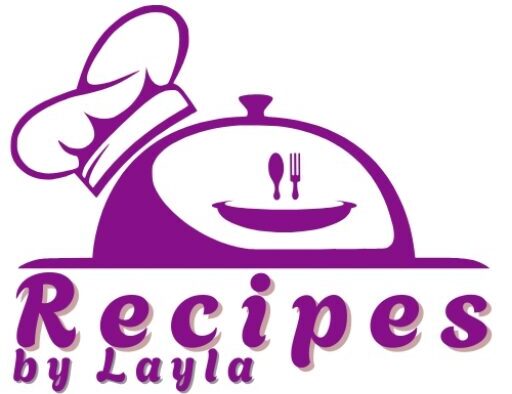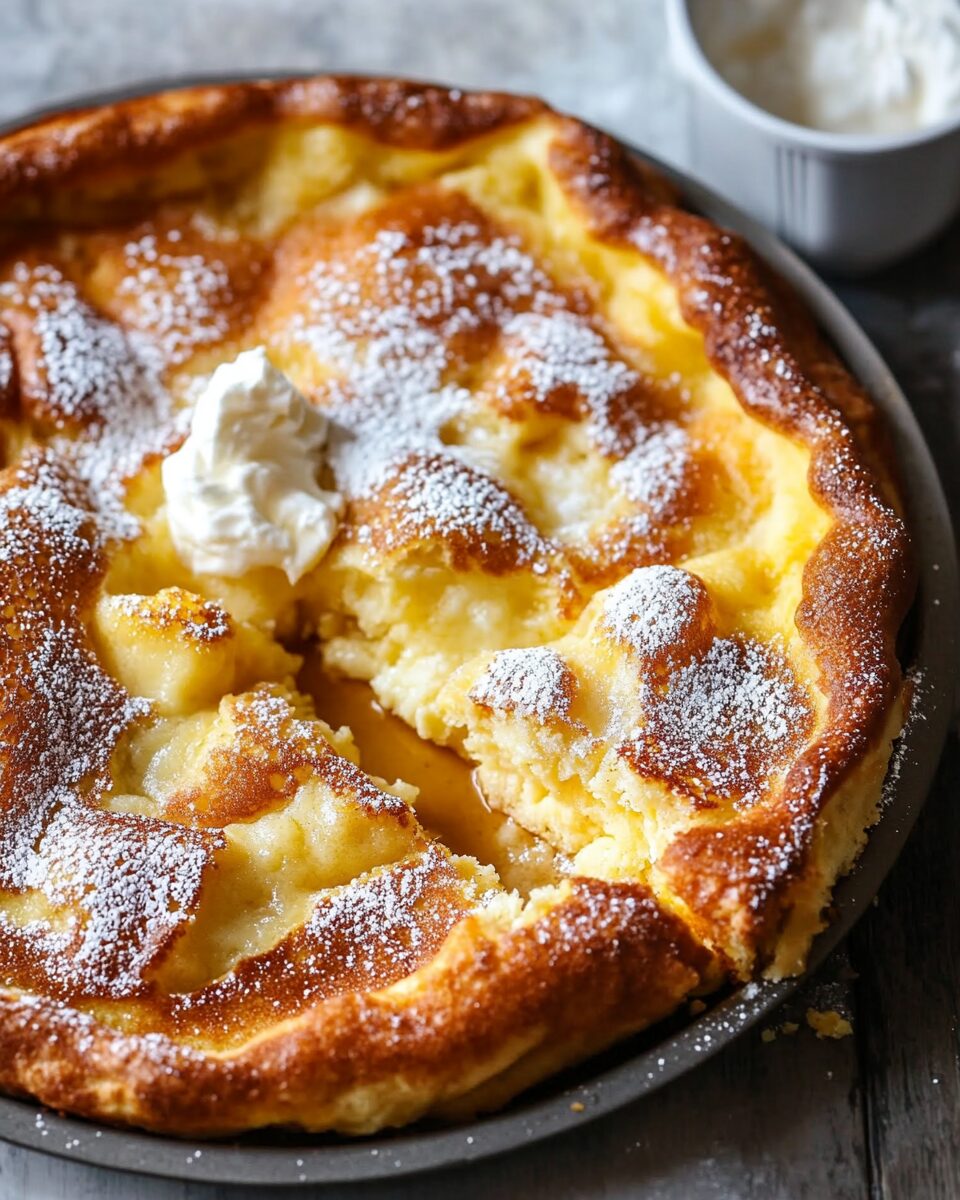The Baked German Pancake, also known as a Dutch Baby, is a simple yet spectacular breakfast or brunch treat. Made with just six pantry staples, it puffs dramatically in the oven, forming golden edges and a light, custardy center. This no-flip pancake is quick to prepare and incredibly customizable with toppings like powdered sugar, maple syrup, fresh berries, or whipped cream. It’s a crowd-pleasing recipe perfect for weekends or special mornings.
Full Recipe:
Ingredients
-
6 large eggs
-
1 cup milk
-
1 cup all-purpose flour
-
1 pinch of salt
-
1 teaspoon vanilla extract
-
5 tablespoons unsalted butter
Directions
Step 1: Preheat Oven & Prepare Pan
-
Preheat your oven to 425ºF (220ºC).
-
Place the butter in a 9×13-inch baking pan and set it in the oven until fully melted.
Step 2: Make the Batter
-
Add eggs, milk, flour, salt, and vanilla to a blender.
-
Blend until the batter is smooth and lump-free.
Step 3: Bake the Pancake
-
Carefully pour the batter into the hot baking dish over the melted butter.
-
Bake for 22–27 minutes, until the pancake is puffed up and golden brown around the edges.
Step 4: Serve
-
Serve immediately while puffy.
-
Top with powdered sugar, berries, syrup, nuts, jam, or any topping of your choice.
Nutrients (approximate per serving – serves 8)
-
Calories: ~180–200
-
Protein: ~7g
-
Fat: ~10g
-
Carbohydrates: ~15–18g
-
Sugar: ~3g
-
Fiber: ~0.5g
Why This Pancake is So Popular
The beauty of a Dutch Baby lies in its dramatic simplicity. You don’t need any fancy tools, special flours, or complicated steps. The oven does the heavy lifting, creating an impressive puff as the batter hits the hot buttered pan. The result is a golden crown with airy walls and a silky center that tastes somewhere between a crepe and a popover. Its look alone is enough to wow guests at a brunch table, but its taste is what brings people back again and again.
Unlike traditional pancakes that require standing at the stove flipping batch after batch, this baked version is hands-off. Once the batter is blended and poured into the hot pan, all that’s left is to watch it rise and crisp into golden perfection. That makes it perfect for stress-free mornings, allowing you to enjoy the process as much as the result.
Origins and Cultural Popularity
Though called a “Dutch Baby” in the United States, this pancake actually draws inspiration from the German Pfannkuchen or Dutch pannenkoeken. It gained its current name and widespread fame in the early 1900s when a Seattle café owner’s daughter referred to the dish as a “Dutch Baby”—a term that stuck and spread.
Its European roots are reflected in the simplicity of ingredients: eggs, flour, and milk. These staples were once common in farmhouse cooking and were used in recipes that needed to be hearty, economical, and filling. Today, that simplicity is still appreciated, but it’s the pancake’s theatrical rise and versatility that steal the spotlight.
Texture and Taste
A well-made Dutch Baby has a distinctly unique texture. The edges puff up like a popover, crisp and golden, while the center remains soft and custardy—almost like a baked crepe or thick pancake. There’s a gentle eggy flavor from the batter, subtly sweetened by the vanilla, and perfectly balanced by the richness of butter that’s infused throughout.
It’s also a blank canvas for flavor. While delicious on its own, it can be elevated with sweet toppings like powdered sugar, fresh fruit, maple syrup, cinnamon apples, or whipped cream. For a savory twist, it can be paired with sautéed vegetables, cheese, herbs, or even bacon and eggs. This versatility makes it suitable for all taste preferences and dietary needs.
Quick and Easy for All Skill Levels
Even for those who are new to cooking or typically shy away from baking, the Dutch Baby is refreshingly forgiving. The batter is made in a blender—no need for whisking or mixing bowls—and it’s poured straight into a hot buttered pan. That simple process delivers a big payoff, making it a favorite among beginner cooks and seasoned bakers alike.
Clean-up is minimal, especially since everything can be prepped in one blender and baked in one dish. It’s a great introduction to baking for kids or teens and can be easily scaled for small families or large groups.
Ideal for Weekends and Celebrations
This pancake isn’t just another weekday breakfast—it’s a dish with a bit of flair, perfect for when you want to elevate your morning without much extra effort. Think birthdays, holidays, brunch parties, or even cozy Sundays when you want something special but still easy. It serves 6 to 8 people depending on portion size, making it a great dish for entertaining.
Since it looks so impressive when it comes out of the oven, it’s also a social media favorite. Serve it right away while puffed, as it does deflate a bit over time—though it’s just as tasty either way. With its golden edges and airy rise, it’s just begging to be shared on Instagram before you drizzle it with maple syrup or dust it with powdered sugar.
Customizations and Topping Ideas
The Dutch Baby is endlessly adaptable. While the classic version includes vanilla and a bit of salt, you can add spices like cinnamon or nutmeg to the batter for warmth and depth. For a savory spin, reduce or omit the vanilla, and mix in finely chopped herbs, cheese, or garlic.
Topping possibilities are endless:
-
Sweet: Fresh berries, lemon zest, maple syrup, honey, whipped cream, caramelized apples, or chocolate chips.
-
Savory: Sautéed spinach, ham, crumbled bacon, roasted tomatoes, or even a poached egg.
These variations make the dish highly versatile and suitable for all seasons and occasions.
Nutritious and Balanced
Each serving of this pancake provides around 180–200 calories, along with about 7 grams of protein and 10 grams of fat. Thanks to the eggs and milk, it offers a modest amount of protein and healthy fats to help you feel full longer. It’s also lower in sugar compared to many traditional pancakes, especially when you control the toppings.
For a lighter version, you can use low-fat milk, reduce the amount of butter, or serve with fresh fruit instead of sugary syrups. For gluten-free diets, a gluten-free flour blend can be substituted with good results.
Make It Your Own
If you find yourself returning to this recipe often—and you likely will—it’s fun to play around with new flavor themes. Make a tropical Dutch Baby with coconut milk and mango, or a fall-inspired version with pumpkin puree and cinnamon. You could even create mini versions by dividing the batter into ramekins or muffin tins for individual servings.
The base is so adaptable that it serves as an excellent foundation for creative experimentation. It’s also great for using up extra eggs or milk before they expire, since the ingredient list is short and pantry-friendly.
Conclusion
The Baked German Pancake (Dutch Baby) is the perfect blend of simple ingredients, easy technique, and impressive results. With its puffy golden edges, tender center, and endless topping options, it’s a breakfast dish that never fails to delight. It’s easy enough for weekdays, special enough for holidays, and customizable for any taste. Whether you’re feeding family, friends, or just yourself, this recipe is one you’ll want to keep in your repertoire and reinvent again and again. With just a blender, a hot oven, and a few pantry staples, you can turn an ordinary morning into something memorable.






